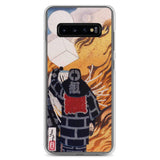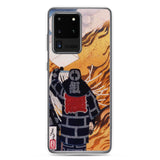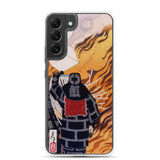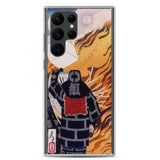'The Moon Through Smoke' by Tsukioka Yoshitoshi, 1886. From the series 'One Hundred Aspects of the Moon. This image is also available on:
Stickers
Tote Bags
T-Shirts
Hoodies
iPhone Cases
Throw Pillows
Through all the wars and conflicts of Japanese history, all the battles and sieges, all the coups and all the conquests, the most dangerous enemy a Japanese city faced was always fire. Japan's earthquake-prone geology meant that stone was used far less frequently for building than in Europe and brick was almost unheard of, so Japanese urban areas - built mostly of wood and paper - were ever a disaster waiting to happen. Fire could come at any moment and destroy whole cities. Standing constant watch against this ancient enemy were the town fire brigades.
In the early years of the Edo period (1603 - 1867) firefighting was still conducted in the traditional manner, i.e. anyone who happened to be nearby grabbed a bucket. Some lords organised their samurai into firefighters, and in the cities merchants would also pay to form fire brigades, but the amount of damage fires caused every year finally persuaded the Tokugawa Shogunate that the system should be formalized and made a government responsibility. By the mid 18th century, every town had an official fire brigade, providing gainful employment to many samurai who would otherwise have become destitute in the long era of peace. Edo (Tokyo) was large enough to require several brigades, and they became tight-knit bands almost akin to military regiments, who frequently skirmished with rival groups.
As well as the attitude, Edo fire brigades also carried over a lot of the equipment and organization from their samurai forefathers. They wore armor, although rather than lacquered iron they had quilted jackets and headgear, designed to be soaked in water and retain it to protect them from the flames; on these were emblazoned insignia much like a samurai's crest. A matoi (standard) would be taken to the roof and used to direct firemen below, where other signals would be lost among the noise and smoke. In this print we see the standard bearer of Number One company, with his matoi topped with a cube and sphere, facing off against a rival standard bearer on the roof opposite (right side of picture). Fire brigades were paid per building they saved, so there was an incentive to drive off rivals and keep the rewards - and the glory - for themselves.
Yoshitoshi made this print in 1886. By this point, the samurai had been abolished as a class and Japan was rapidly modernizing and westernising. Firemen had always been romanticized as glamorous, daredevil figures, but in an age where the streets of Tokyo were increasingly filled with men in western-style suits, the fire brigades in their bombastic outfits were a colorful reminder of a fading world.
Product Details:
Samsung Phone Case, available for 13 different variants.
FREE SHIPPING
Average Delivery Time: 7 - 11 working days
• Solid polycarbonate back
• 0.02″ (0.5 mm) raised bezel
• See-through sides
• Wireless charging compatible
• Easy to take on and off


























